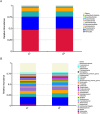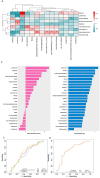The associations between gut microbiota and fecal metabolites with intelligence quotient in preschoolers
- PMID: 39455934
- PMCID: PMC11515365
- DOI: 10.1186/s12866-024-03579-9
The associations between gut microbiota and fecal metabolites with intelligence quotient in preschoolers
Abstract
Background: The awareness of the association between the gut microbiota and human intelligence levels is increasing, but the findings are inconsistent. Furthermore, few research have explored the potential role of gut microbial metabolites in this association. This study aimed to investigate the associations of the gut microbiota and fecal metabolome with intelligence quotient (IQ) in preschoolers.
Methods: The 16 S rRNA sequencing and widely targeted metabolomics were applied to analyze the gut microbiota and fecal metabolites of 150 children aged 3-6 years. The Wechsler Preschool and Primary Scale of Intelligence, Fourth Edition (WPPSI-IV) was used to assess the cognitive competence.
Results: The observed species index, gut microbiome health index, and microbial dysbiosis index presented significant differences between children with full-scale IQ (FSIQ) below the borderline (G1) and those with average or above-average (all P < 0.05). The abundance of Acinetobacter, Blautia, Faecalibacterium, Prevotella_9, Subdoligranulum, Collinsella, Dialister, Holdemanella, and Methanobrevibacter was significantly associated with preschooler's WPPSI-IV scores (P < 0.05). In all, 87 differential metabolites were identified, mainly including amino acid and its metabolites, fatty acyl, and benzene and substituted derivatives. The differential fecal metabolites carnitine C20:1-OH, 4-hydroxydebrisoquine, pantothenol, creatine, N,N-bis(2-hydroxyethyl) dodecanamide, FFA(20:5), zerumbone, (R)-(-)-2-phenylpropionic acid, M-toluene acetic acid, trans-cinnamaldehyde, isonicotinic acid, val-arg, traumatin, and 3-methyl-4-hydroxybenzaldehyde were significantly associated with the preschooler's WPPSI-IV scores (P < 0.05). The combination of Acinetobacter, Isonicotinic acid, and 3-methyl-4-hydroxybenzaldehydenine may demonstrate increased discriminatory power for preschoolers in G1.
Conclusion: This study reveals a potential association between gut microbiome and metabolites with IQ in preschoolers, providing new directions for future research and practical applications. However, due to limitations such as the small sample size, unclear causality, and the complexity of metabolites, more validation studies are still needed to further elucidate the mechanisms and stability of these associations.
Keywords: Fecal metabolome; Gut microbiota; Intelligence quotient; Preschoolers.
© 2024. The Author(s).
Conflict of interest statement
The authors declare no competing interests.
Figures







Similar articles
-
Disturbed microbial ecology in Alzheimer's disease: evidence from the gut microbiota and fecal metabolome.BMC Microbiol. 2021 Aug 12;21(1):226. doi: 10.1186/s12866-021-02286-z. BMC Microbiol. 2021. PMID: 34384375 Free PMC article.
-
Analysis of the gut microbiota and fecal metabolites in people living with HIV.Microbiol Spectr. 2024 Nov 5;12(11):e0023824. doi: 10.1128/spectrum.00238-24. Epub 2024 Sep 18. Microbiol Spectr. 2024. PMID: 39291988 Free PMC article.
-
Gut Microbiome and Serum Metabolome Alterations Associated with Isolated Dystonia.mSphere. 2021 Aug 25;6(4):e0028321. doi: 10.1128/mSphere.00283-21. Epub 2021 Aug 4. mSphere. 2021. PMID: 34346706 Free PMC article.
-
Gut microbiota alterations in colorectal adenoma-carcinoma sequence based on 16S rRNA gene sequencing: A systematic review and meta-analysis.Microb Pathog. 2024 Oct;195:106889. doi: 10.1016/j.micpath.2024.106889. Epub 2024 Aug 26. Microb Pathog. 2024. PMID: 39197689
-
The characteristics of the gut microbiota in patients with pulmonary tuberculosis: A systematic review.Diagn Microbiol Infect Dis. 2024 Jul;109(3):116291. doi: 10.1016/j.diagmicrobio.2024.116291. Epub 2024 Mar 30. Diagn Microbiol Infect Dis. 2024. PMID: 38581928
References
-
- Cryan JF, Dinan TG. Mind-altering microorganisms: the impact of the gut microbiota on brain and behaviour. Nat Rev Neurosci. 2012;13(10):701–12. - PubMed
-
- Cowan CSM, Dinan TG, Cryan JF. Annual Research Review: critical windows - the microbiota-gut-brain axis in neurocognitive development. J Child Psychol Psychiatry Allied Discip. 2020;61(3):353–71. - PubMed
MeSH terms
Substances
Grants and funding
LinkOut - more resources
Full Text Sources
Medical
Miscellaneous

